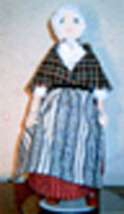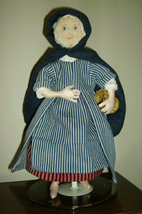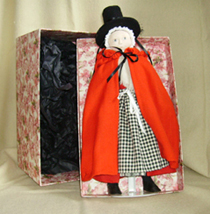Oriel Sargaso
OPEN NOW WITH
Sue Mordan | Janet Bristoll | Seren Mair | Larry E. Mordan
Seren Mair is a dollmaker. Of her work she says: "I started making these dolls after moving to Wales and becoming more and more interested in the language, history and customs of this fascinating country. "Now, I am completely absorbed in the dress of work of the women of Wales, in past times....The clothes that they wore were, in most cases, the only ones they had." more... |
 |
 |
 |
| Indoor Wear | Outdoor Wear | Winter Wear |

Elements of the Costume
Indoor Wear: Dillad Isaf/Undergarments The chemise was a basic cotton top worn next to the skin, either long or short sleeved, and gathered around the neckline. The drawers or pantaloons were also made of cotton. Both garments were plain and unadorned.
Pais/Underskirt The pais was worn over the undergarments and was always a full flannel skirt garthered just above the hips onto a broad cotton waistband which made it less bulky around the waist. Small growing pleats were sewn into the pais and let down as needed. Flannel was very hardwearing but frayed easily so a binding was always sewn over the bottom hem. Flannel was woven on a handloom and usually had a stripe or check pattern and was dyed with locally available materials hence the wide variation of regional colors. Flannel was believed to have healing properties for diseases such as ‘consumption’.
Ffedog/Apron Made from flannel, calico or cotton, the fedog was a large and full garment covering the front of the body from the waist down and was a very important part of every Welsh woman’s wardrobe. As well as keeping the underskirt and betgwn protected from everyday spills and grime, it also functioned as a shopping bag and carrying everything from washing down to the river to vegetables going to market. Top of Page
Siôl/Shawl These were made of wool and varied in size from small whittles or neck scarves to full length shawls that covered the body. These were large squares of hand fringed wool and were used to wrap a baby in a unique way that allowed the woman to work with the baby bound tightly to her body.
Boned/Bonnet This delicate item was made from cotton or, when possible, from lawn. Here was where any frill in an otherwise plain and functional wardrobe was allowed to be seen. Encircling the entire boned there were deep frilled edges or goffers. Many homes had a goffering stick which aided the curling of these frills after each washing. The boned was worn at all times because it helped keep draughts of the neck. Top of Page
Outdoor Wear: Betgwn/Bedgown This was a very heavy duty garment made entirely of flannel with a bodice lined in calico. It was worn like a coat with long or 3/4 length sleeves. The bodice was fitted closely to the body and was open at the front. There were no fastenings but a blackthorn was often used to pin the two sides together. The skirt of the betgwn varied in length from full to a short peplum almost resembling a jacket.
Winter Wear: Clogyn a Het/Cloak & Hat These two items were only for going out. The high stump hat has now become a national symbol but in fact was only in vogue from 1800-1830. For those who could afford it, some were made in Paris from beaver fur, but generally they were homemade from a hard board and covered with felt. The clogyn was an enormous garment, mainly in red but there are examples of blues and browns. The hood was large enough to cover the stump hat for protection from inclement weather.
Hosanau ac Esgidiau / Stockings & Shoes Stockings were mostly knitted by women at home but also formed a cottage industry, in black, navy or white wool. Until the 19th Century, footwear was rarely worn by the poor but clocsiau/clogs and leather shoes began to appear. These were a simple, slip-on design, often made by travelling shoemakers.
Seren Mair's Danygoed Heritage Dolls are no longer available. This page is for information only.
© Oriel Sargaso 2007-2014